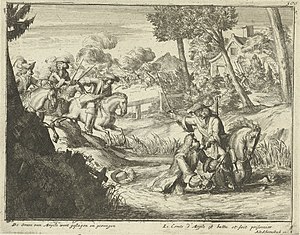| Argyll's Rising | |||||||
|---|---|---|---|---|---|---|---|
 An illustration of Argyll's capture | |||||||
| |||||||
| Belligerents | |||||||
|
|
| ||||||
| Commanders and leaders | |||||||
|
John Murray George Douglas |
Archibald Campbell Patrick Hume John Cochrane (POW) Duncan Campbell Richard Rumbold John Ayloffe | ||||||
| Strength | |||||||
| c. 10,000 | 1,500–2,500 [a] | ||||||
| Casualties and losses | |||||||
| Unknown |
Unknown killed and wounded 323+ captured | ||||||
Argyll's Rising, also known as Argyll's Rebellion, was an attempt in June 1685 to overthrow James II and VII. Led by Archibald Campbell, 9th Earl of Argyll, the rising was intended to tie down Royal forces in Scotland while a simultaneous rebellion under James Scott, 1st Duke of Monmouth began in England. Both rebellions were backed by dissident Protestants opposed to the accession of the Roman Catholic James to the throne.
Argyll, chief of Clan Campbell, planned to raise several thousand men from his own estates and expected to receive additional support from Presbyterian dissidents. He sailed from Holland on 2 May with around 300 men, but on landing in Scotland attracted few recruits. Hampered by Argyll's inexperience as a commander and disagreements amongst the rebel leaders, and pursued by government militia under the Marquess of Atholl, the rebels began to disperse in mid June after an abortive invasion of Lowland Scotland. Most of their leaders were captured, including Argyll, who was executed on 30 June.
Cite error: There are <ref group=lower-alpha> tags or {{efn}} templates on this page, but the references will not show without a {{reflist|group=lower-alpha}} template or {{notelist}} template (see the help page).
